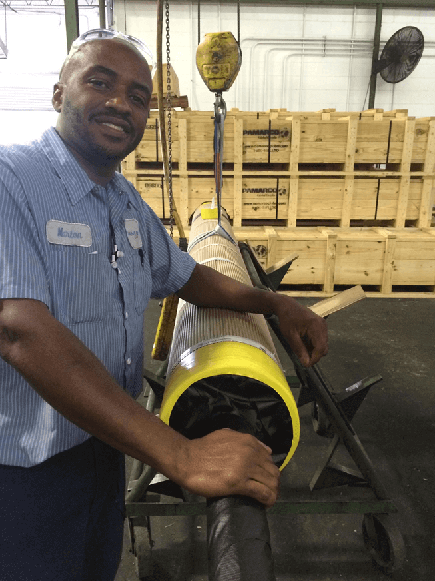Care, Monitoring and Proper Maintenance of Your Anilox Will Go a Long Way in Improving Your Plant’s Bottom Line
Author: John Rastetter
Is your plant running flat out? Are you tired of replacing rolls? Do you think things like “I don’t have the time for preventative maintenance or training.”? If you can’t get color, if you’re stopping to clean plates, if you have rejects, if you’re frustrated with the short lifespan of your rolls: this is for you. I want to show you the positive impact that your plant can have on downtime, quality and cost by taking just two simple steps in the right direction.
We all know that regardless of the industry you work in, quality is required in order to consistently satisfy your customers. With that established, let’s get right to it: how do we maximize consistency and uptime, while ensuring that we are squeezing the highest value out of your investments? There are multiple variables that contribute to your measurement criteria and it is important to understand each one. Based on our current research, however, one of the most significant contributors is an often overlooked one: the anilox roll. I want to focus on the reasons for anilox issues, what can be done to fix the problem and how you can get the most out of this investment.
Step One: Training Your Operators

What I want to ensure is that from the moment of installation and throughout its life, your anilox is living up its highest potential. We can start to understand how this is possible by defining what Pamarco sees when a roll arrives at one of our six facilities for re-engraving. The top three reasons, in order of frequency, are as follows:
- We see damage from doctor blades, improper chamber adjustment and the all-impressive “L” shaped indentation that points to an allen key. Damage directly indicates that training is needed. Care and maintenance seminars that we regularly offer can provide the training and skill advancement necessary to extend the life of your investment. Training alone can annually save thousands of dollars in added costs and downtime.
- We recommend specific cleaning chemicals and methods to get the most out of your anilox roll. If these recommendations are not followed, the likelihood of corrosion increases exponentially. Pamarco has several levels of corrosion treatments that can be utilized to build up anilox resistance to corrosion. Of course, as the protection level increases the cost increases as well. No matter what Pamarco or any other anilox manufacturer does, however, these treatments can only extend the life of the roll if the operator continues to use cleaning chemicals and/or procedures that are outside the recommendations.
In a recent conversation regarding plugged rolls, I was told of a technique that involves the application of a high pH cleaner, wrapping the wet roll in plastic, and then letting it sit over the weekend. Another roll cleaning method I’ve often heard is using oven cleaner. In both cases the roll was definitely cleaned, but the end result is that it shortens the life of the roll by blistering the ceramic. It could take 24 hours, it could take a weekend, it could take 6 months, but it will corrode faster than it should. Pamarco can help your investment have a longer lifespan by training and providing approved cleaning equipment like Sanilox or cleaning chemistry like CellRestore.
- All anilox rolls will require replacement at some point. Most often this is caused by the expected abrasion that takes place in the normal operation of a flexo or die cutter. Doctor blade choice, chamber settings and press settings all play a large part in increasing or decreasing the life of an anilox. Again, training and proper maintenance will make a huge difference. What we want to do is extend this life as long as possible, understand where the anilox is in its life cycle and plan for its re-engrave. The most often used rule is to schedule replacement when available volume drops by 12% to 15% from the targeted BCM.
Starting to see a theme here? Good. There is one. Wear and damage are all going to happen. How soon and how badly they happen is up to you. Corrosion can be prevented by following guidelines. By taking the simple step of training your operators, you are taking the power to make your investment count for more into your own hands. The knowledge gleaned from Step Two, however, is as important as training your operators.
Step Two: Understanding Your Anilox Condition
How long does an anilox roll last? How is yours doing? What can you expect from it? To help you understand where your specific anilox life cycle is and to determine its overall condition, Pamarco runs an extensive anilox audit program. We will audit a customer’s complete pressroom upon request. That’s every anilox: in and out of the equipment. We recognize that you can’t shut down production and we don’t want you to; we work around your schedule to avoid disruption.
Our audit process gives you the ability to truly understand the condition of each of your rolls. The report includes a photomicrograph of the roll with details on volume, depth to opening ratio, wall width and condition. Over the past ten years, we have audited well over 70,000 anilox and have found that nearly 65% of rolls show some degree of plugging. The audit process and the detailed report are great tools to help your maintenance and quality department identify the problem areas and take action. Once the problem is discovered, preventative maintenance and operator training can help ensure smooth production in the future.
Let’s review those figures:

While Step One and Step Two are great ways to increase your production levels while keeping the cost down, engraving technology is the real key to life and consistency.
We can’t have a discussion on maximizing the life of anilox rolls without talking about the manufacturing process. Pamarco takes great pride in building each roll into the type of quality anilox that guarantees you are getting the most out of your hard earned dollars. Whether you are running a Langston or the most modern MHI, we build and rebuild our anilox rolls to OEM specifications. This means that the journal tolerances, OD and TIR are all true to specification. Precision of this caliber provides you with maximum performance and makes certain that the anilox doesn’t slow you down.
We use the latest technology in plasma spray and diamond stone polish the ceramic to exact tolerances before laser engraving. We then use the latest 500 watt fiber optic laser technology and software to carve the desired cell type, LPI and volume. By starting the final process of machine diamond film polishing with the ideal engraving, we are able to polish to an exact volume and deliver the most robust roll. In addition, the diamond machine film process ensures a flat surface with uniform walls and a well defined cell structure. This allows rapid doctor blade set-in and uniform ink metering.

New or reconditioned: all anilox rolls are produced to original OEM specifications.
We build in the same consistency roll to roll as well. With 5 engraving facilities in the US and 1 in the UK, each plant has access to our database containing engraving specifications, laser settings and the final roll results of every roll produced in any plant. This means that, regardless of production location, we can duplicate any engraving result. In conjunction with a knowledge base consisting of press variables, board types and print requirements, this combination has yielded engraving specifications for virtually all types of work produced. Developed over time using a significant amount of detailed print results, the following table provides specifics for many applications:
The Final Word:
Care, monitoring and proper maintenance of your anilox will go a long way in improving your plant’s bottom line. Take advantage of the full services of your anilox supplier: have your rolls audited, schedule a pressroom review and begin regular care and handling seminars. Pamarco is ready when you are.
